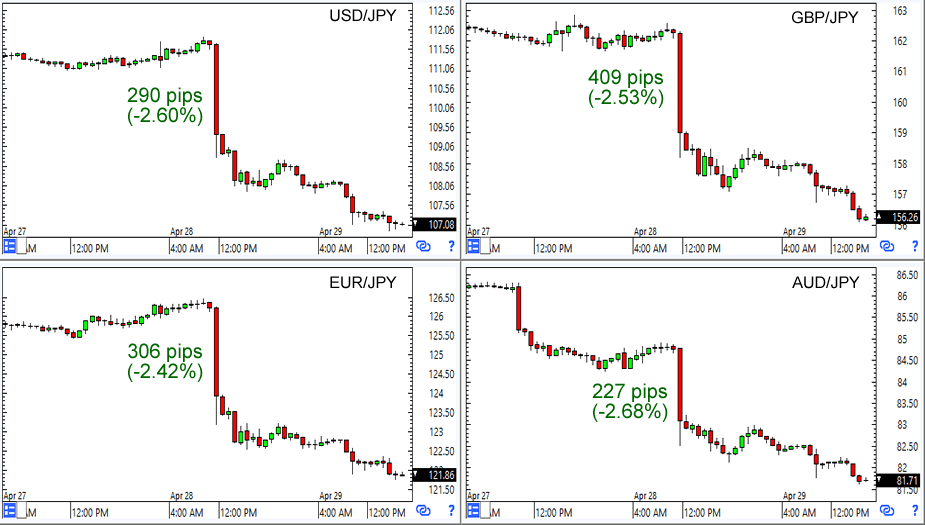Last Thursday the Bank of Japan (BOJ) caused ruckus in the markets by not making any changes to its monetary policies. Wait, what?!
How can a no-change decision have so much impact on the major currencies? Let’s break down the details.
1. The BOJ didn’t make any changes to its policies
As I mentioned in my preview earlier this week, a lot of market players were expecting the BOJ to add more stimulus into the economy. And why not? Japan’s indicators have been deteriorating, domestic inflationary pressures remain muted, and the yen has gained a lot of ground against its counterparts this year.
Instead, Kuroda and his gang have decided to keep their monetary policies steady. See, they believe that two months is too short to assess the impact of their latest policy changes (remember the NIRP?). Their interest rates is kept at -0.1% while the asset-buying program remains at a pace of 80 trillion JPY a year.
2. But it did change its inflation and growth estimates
With no changes to its policies, analysts paid closer attention to the BOJ’s assessment of the economy. Here’s the gist of the BOJ’s fiscal year adjustments since its January release:
-
2016 growth down from 1.5% to 1.2%
-
2016 inflation (y/y) down from 0.8% to 0.5%
-
2017 growth down from 0.3% to 0.1%
-
2017 inflation (y/y) down from 2.8% to 2.7%
-
2018 inflation (y/y) 1.9%
There are two takeaways from the figures above. First, the central bank has further delayed the achievement of its 2.0% inflation target from the first half of 2017 to the 2017-2018 fiscal year. Next, the low growth AND high inflation estimates in 2017 is consistent with speculations of an increase in the value added tax, something that PM Shinzo Abe is expected to implement in April 2017. Will this mean that Abe won’t be delaying the tax increase?
Overall the BOJ has mixed assessment for the economy, saying that growth and business investment are still on a moderate recovery trend while exports recovery had paused and some consumption indicators have shown weaknesses.
3. The BOJ allotted budget for earthquake-related projects
By a unanimous vote the BOJ crew has decided to help restoration and rebuilding operations in Kumamoto following an earthquake a few days ago. The central bank is set to provide loans of up to 300 billion JPY at 0.0% interest rate to its financial institutions.
Since the BOJ’s NIRP charges a 0.1% rate to banks, the BOJ says that twice the amount that the banks will borrow will go to their macro add-on balances, to which a 0.0% rate is applied. Talk about giving incentives!
4. The yen shot up across the board
What surprised a lot of forex newbies was how the yen STRENGTHENED when market players were actually disappointed with the BOJ’s non-action. Shouldn’t the yen WEAKEN in times like these? There are two possible reasons for this.
First, the lack of additional stimulus disappointed a lot of equities traders, which created a risk-averse trading environment. Ironically, it’s the low-yielding currencies like the yen that are usually pushed higher in times of risk aversion.
Another reason for the yen’s sudden and sharp strength is that forex traders have deduced that the BOJ isn’t worried about the yen’s recent gains after all. If you recall, the yen was already around 8.6% higher against the Greenback even before the BOJ printed its decision. A non-action signaled to traders that there won’t be much opposition from Kuroda if they push the yen higher… and so they did.
Just because the BOJ didn’t make any policy changes doesn’t mean that it will continue to stand pat next month. Right now the central bank is willing to wait for a couple more months to see the impact of their negative interest rate policy. However, Kuroda and his team might not wait if inflation continues to disappoint, weak global growth continues to threaten Japan’s exports, or if the notable yen increases persist.
BabyPips.com does not warrant or guarantee the accuracy, timeliness or completeness to its service or information it provides. BabyPips.com does not give, whatsoever, warranties, expressed or implied, to the results to be obtained by using its services or information it provided. Users are trading at their own risk and BabyPips.com shall not be responsible under any circumstances for the consequences of such activities. Babypips.com and its affiliates will not, in any event, be liable to users or any third parties for any consequential damages, however arising, including but not limited to damages caused by negligence whether such damages were foreseen or unforeseen.
Recommended Content
Editors’ Picks
AUD/USD post moderate gains on solid US data, weak Aussie PMI

The Australian Dollar registered solid gains of 0.65% against the US Dollar on Thursday, courtesy of an upbeat market mood amid solid economic data from the United States. However, the Federal Reserve’s latest monetary policy decision is still weighing on the Greenback. The AUD/USD trades at 0.6567.
EUR/USD recovers to top end of consolidation ahead of Friday’s US NFP

EUR/USD drove back to the top end of recent consolidation on Thursday, recovering chart territory north of the 1.0700 handle as market risk appetite regains balance heading into another US Nonfarm Payrolls Friday.
Gold recoils on hawkish Fed moves, unfazed by dropping yields and softer US Dollar

Gold price clings to the $2,300 figure in the mid-North American session on Thursday amid an upbeat market sentiment, falling US Treasury yields, and a softer US Dollar. Traders are still digesting Wednesday’s Federal Reserve decision to hold rates unchanged.
Ethereum may sustain trading inside key range, ETH ETFs to be delayed until 2025

Ethereum is beginning to show signs of recovery on Thursday despite a second consecutive day of poor performance in Hong Kong's spot Ethereum ETFs. Bloomberg analyst James Seyffart has also shared that a spot Ethereum ETF may not happen in the US in 2024.
FOMC in the rear-view mirror – NFP eyed

The update from May’s FOMC rate announcement proved more dovish than expected, which naturally weighed on the US dollar (sending the DXY to lows of 105.44) and US yields, as well as, initially at least, underpinning major US equity indices.
